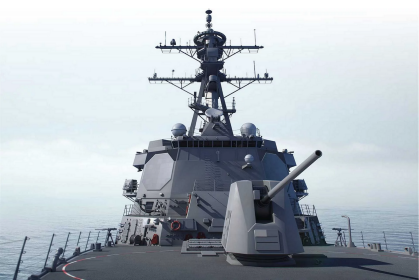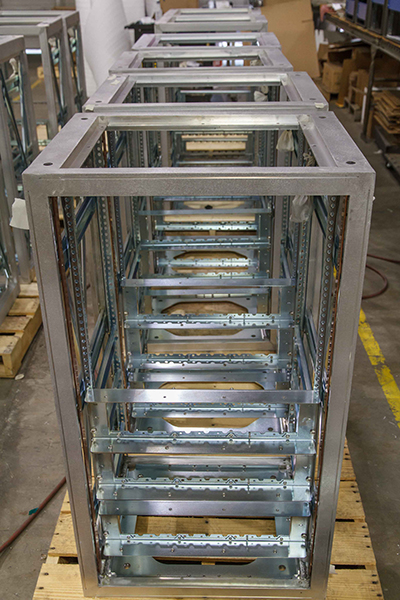With the increased reliance on electronics needing to operate autonomously, modern military and industrial rugged cabinets are more than just a box designed to house electronics. They now serve as enabling platforms that ensure electronics will function as needed in remote and harsh environments.

And as more embedded systems and electronics equipment are being used in railway, automation, air, land and sea vehicles, and located in remote locations outdoors, sensitive electronics must be protected in robust enclosures. The mechanical properties to consider for effective rugged cabinet design include structural integrity, EMI protection and thermal management to improve system reliability. (Figure 1)
What’s Driving Rugged Enclosure Design
Four main aspects that have redefined the expectations for enclosure performance in harsh environments include:
• Edge computing and mobility
• SWaP and high-density electronics
• Remote or unattended operations
• Flexible/custom deployments
Edge computing and mobility. With electronics no longer housed only in secure and stable environments, such as data centers and server rooms, enclosures must protect electronics that operate in the field. The edge-based computing environment has put new emphasis on ruggedization, with systems needing to withstand continuous and variable environmental and mechanical stress, such as shock, vibration, temperatures and contaminants.
SWaP and high-density electronics. The computational horsepower packed into today’s compact embedded systems are imparting unprecedented levels of stress and thermal management on components. This densely packed environment means that even minor vibrations can cause fretting or connector issues, for example.
Remote or unattended operations. Automated and unmanned systems are quickly becoming the norm in a host of military and industrial applications. System reliability is paramount, requiring strict adherence to industry standards, built-in redundancy and robust hardware the norm to ensure a system stays running until maintenance is possible, in the event of an error or failure. (Figure 2)

Flexible/custom deployments. Adapting a COTS enclosure to a specific use has long been a mainstay of embedded system development. What is new about this concept is the increased reliance on COTS-based systems, as open standards-based computing is taking a more prominent role, especially in defense applications. Flexibility and adaptability in a cabinet’s size, mounting, or layout are as important as its baseline strength. Some may argue it’s become a strategic advantage in modern deployments.
How Standards Impact Rugged Cabinet Design
Several military and industrial standards form the backbone of rugged cabinet design for harsh environments. The list below outlines a few of the more common methods to ensure reliability and performance in a modern enclosure design.
• MIL-STD-810 (Environmental): Considered the “all-weather, all-terrain” baseline standard, MIL-STD-810 ensures a cabinet (with its electronics) can endure the worst environmental extremes it might encounter in service: temperature, humidity, moisture and dust ingress, vibration, etc.
• MIL-S-901D (Shock): Cabinets qualified to MIL-S-901D (often called Grade A shock and used primarily for shipboard applications) have demonstrated they can withstand extreme shock and sudden impacts, ensuring mounted equipment can survive without structural failure. (Figure 3)
• MIL-STD-167-1A (Vibration): Also mainly for shipboard applications, MIL-STD-167-1A ensures long-term vibration endurance by shaking an enclosure across various frequencies. Compliant cabinets often incorporate reinforced structures or vibration isolation mounts to absorb persistent vibrations as well as employ proper weight distribution and bracing, to reduce component and joint overstressing.

• MIL-STD-461* (EMI/EMC): This military standard both limits the noise a device or enclosure can emit, as well as determines how immune it must be to external interference. A conductive, well-bonded enclosure (acting as a Faraday cage) will provide proper grounding and any openings (ventilation holes, cable ports) must be treated with EMI filters or shielded connectors to maintain shielding effectiveness.
• Telcordia GR-63-CORE (Zone 4 Seismic): Cabinets complying to GR-63-CORE, a common benchmark for enclosures needing to withstand worst-case seismic vibrations, usually incorporate sturdy anchoring provisions and often external bracing or snubbers to prevent tip-over or other damage caused by earthquakes.
*The complex relationship between EMI shielding and system airflow for cooling requires a design where the addition components that help mitigate EMI (filters, gaskets, seals, etc.) won’t impede with their primary function, yet allow for the needed cooling and connectivity of the larger system.
Aluminum Construction: Benefits Over Steel
A significant industry innovation has been the move toward lightweight, corrosion-resistant aluminum extruded frame construction. With a strength-to weight ratio of approximately two times greater than steel and heat conduction up to four times better, aluminum offers strategic advantages in harsh environments, especially for mobile and airborne applications.
Extruded aluminum frame cabinets require little to no welding during assembly or transport, so they can be transported to and assembled in tight spaces. Fitting a one-piece welded frame through a submarine hatch or a narrow doorway just may not be feasible.
For example, the modular design of Optima Stantron’s rugged cabinets use a system of horizontal and vertical aluminum extrusions that bolt together with steel corner inserts to form a rigid frame, combining the best properties of both metals. Because the basic extruded components can be reconfigured into different sizes or styles of cabinets without custom tooling each time, these modular, rugged cabinets offer shorter lead times and lower non-recurring engineering cost. (Figure 4)

Thermal Management Options in Enclosure Design
When developing rugged systems for harsh and remote environments, it’s important to keep in mind that it’s not just the boards and power supplies that need to manage the heat. The complete thermal profile, from the fans, filters and coolers to the insulation and sensors, all contribute to keeping those boards running optimally for the long haul, as heat most certainly can cause erratic behavior or premature failures.
Although passive cooling may be the simplest cooling method, the highly integrated and densely packed cabinets in today’s rugged environments may need a more nuanced approach. Passive cooling steps up the air being circulated via fans and blowers, but if the air surrounding the enclosure itself is hot and humid, closed-loop cooling via sealed air-conditioning or heat exchanger units may be needed.
As electronic density has increased, more innovative cooling methods have been implemented, including conduction, which uses the cabinet itself to pull heat off the system and even liquid cooling for extreme power densities.
Simulating the airflow and temperature distribution of a system will help determine the thermal profile and optimal cooling method as well as enable engineering to account for environmental extremes that the system may endure. This helps reduce the risk of failure, as excessive heat is truly the enemy of electronic reliability.
Conclusion: Rugged Cabinets Require Careful Design Considerations
By carefully selecting, configuring, and testing rugged cabinets as well as adhering to industry standards to benchmark performance, engineers and program managers can reduce risk, improve reliability, and extend the lifecycle of critical systems.
Want to learn more about rugged cabinet design? Check out our 4-part white paper series that explores these concepts in detail as well as provides several use cases of reliable, rugged and modular cabinet design.

